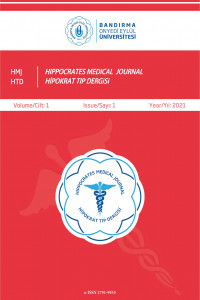Koroner Arter Bypass Ameliyatında Kullanılmak Üzere Hazırlanan Büyük Safen Veninde Gelişen Endotel Hasarının Histopatolojik Sonuçları
CD34 Pozitif, TUNEL Pozitif, Endotel Hücresi, Bypass Cerrahisi, Histopatoloji
Histopathological Results of Endothelıal Injury in Great Saphaneous Vein Harvested For Coronay Artery Bypass Surgery
CD34 Positive, TUNEL Positive, Endothelial Cell, Bypass Surgery, Histopathology,
___
- Taggart DP, D’Amico R, Altman DG. Effect of arterial revascularisation on survival: a systematic review of studies comparing bilateral and single internal mammary arteries Lancet, 2001;358:870–5.
- Favaloro RG. Saphenous vein autograft replacement of severe segmental coronery artery acclusion: operative technique. Ann Thorac Surg, 1968;5(4):334-9.
- Duran E, Halıcı Ü. Dünyada kalp-damar cerrahisinin tarihçesi. Duran E (Editör). Kalp ve Damar Cerrahisi’nde. İstanbul: Çapa Tıp Kitabevi; 2004. s.3-13.
- Fitzgibbon GM, Kafka HB, Leach HA, Keon WJ, Hooper GD, Burton JR. Coronary bypass graft fate and patient outcome: angiographic follow-up of 5,065 grafts related to survival in reoperation in 1,388 patients during 25 years. J Am Coll Cardiol, 1996;28:616-26
- Fulton GJ, Davies MG, Hagen PO. Preservation of the endothelium ın venous bypass grafts: relevance for graft patency. Asia Pacific Heart J, 1997;6(2):98-106.
- Tsui JC, Souza DS, Filbey D, Karlsson MG, Dashwood MR. Localization of nitric oxide synthase in saphenousvein grafts harvested with a novel “no-touch” technique: potential role of nitric oxide contribution to improved early graft patency rates. J Vasc Surg, 2002;35(2):356-62.
- Boerboom LE, Bonchek LI, Kissebah AH, Werner PH, Pepper JR, Olinger GN et al. Effect of surgical trauma on tissue lipids in primate vein grafts: relation of plasma lipids. Circulation, 1980;62:142-7.
- Bonchek LI. Prevention of endothelial damage during preparation of saphenous veins for bypass grafting. J Thorac Cardiovasc Surg, 1980;79(6):911-5.
- Angelini GD, Williams HM, Morgan R, Newby AC. Distention promotes platelet and leukocyte adhesion and reduces short-term patency in pig arteriovenous bypass grafts. J Thorac Cardiovasc Surg, 1990;99(3):433-9.
- He G, Rosenfeldt FL, Angus JA. Pharmacological relaxation of the saphenous vein during harvesting for coronary artery bypass grafting. Ann Thorac Surg, 1993;55:1210-7.
- Souza DSR, Christofferson RHB, Bomfim V, Filbey D. “No-touch” Technique using Saphenous Vein Harvested with its Surrounding Tissue for Coronary Artery Bypass Grafting Maintains an Intact Endothelium. Scand Cardiovasc J, 1999;(33):323-9.
- Souza DS, Bomfim V, Skoglund H, Dashwood MR, Borowiec JW, Bodin L et.al. High early patency of saphenous vein graft for coronary artery bypass harvested with surrounding tissue. Ann Thorac Surg, 2001;71:797-800.
- Thatte HS, Khuri SF. The coronary artery bypass conduit: I. Intraoperative endothelial injury and its implication on graft patency. Ann Thorac Surg, 2001;72:2245-52.
- Karabulut H, Karabulut 0, Arbak S, Şan T, Sokullu O, Korukçu A ve ark. Koroner bypass cerrahisinde kullanılan safen veninin hazırlanmasinda endotel hasarı: Işık ve elektron mikroskopik inceleme Türk Kardiyoloji Dern Arş, 1998,26:416-24.
- Angelini GD, Passani SL, Breckenridge IM, Newby AC. Nature and pressure dependence of damage induced by distension of human saphenous vein coronary artery bypass grafts. Cardiovasc Res, 1987;21(12):902-7.
- Cambria RP, Megerman J, Abbott WM. Endothelial preservation in reversed and in situ autogeneous vein grafts: a quantitative experimental study. Ann Surg, 1985;202:50-5.
- Kosugi I, Urayama H, Kasashima F, Ohtake H, Watanabe Y. Matrix metalloproreinase-9 and urokinase-type plasminogen activator in varicose veins. Ann Vasc Surg, 2003;17:234-8.
- O’Donnell TF, Iafrati MD. Varicose veins. In: Haimovici H, Ascer E, Hollier LH, Strandness DE, Towne JB (Eds). Haimovici’s Vascular Surgery Principles and Techniques. 4th Ed. Cambridge Massachusets, USA: Blackwell Science Inc; 1996. p.1187-98.
- Yayın Aralığı: Yılda 3 Sayı
- Başlangıç: 2021
- Yayıncı: Bandırma Onyedi Eylül Üniversitesi
Muhammet Murat CANTÜRK, Hayrettin TEKÜMİT
Pseudo-Meigs Sendromu ile Başvuran Struma Ovarii: Bir Olgu Sunumu ve Literatürün Gözden Geçirilmesi
Yakup BAYKUŞ, Rulin DENİZ, Muhammet Bora UZUNER, Alihan TIĞLI, Nazlı ŞENER
Erkek Hastalarda Behçet Hastalığının AÜSS Üzerine Etkileri
